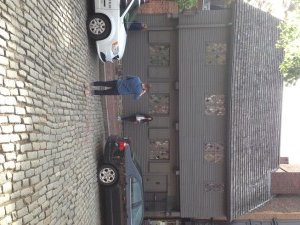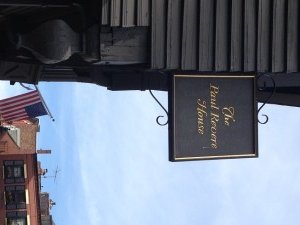Boston Massachusetts is home to the house that Paul Revere lived in when he left on his famous ride to Lexington.This was the famous “Midnight Ride” where Revere alerted Samuel Adams and John Hancock that the British were on the way to arrest them.

Boston’s Historic North End
This structure is the oldest building in downtown Boston. Boston’s oldest residential neighborhood, the North End, contains some of the city’s oldest buildings. The North End still has plenty of charm. The windy, cobbled streets, jumble of architectural styles and the large number of historical sites make this 1/3 square mile of land a real pleasure to traverse.
The North End of Boston overflows with character and charm. Another description of Boston’s North End would be beautiful old architecture and a feeling of romance, plus a wide range of delicious food options.
The Paul Revere Home Line of Ownership
The Revere home, built around 1680, was the residence of well known silversmith Paul Revere and his family. The family lived in this house from 1770 to 1800. There’s a lot of history as to who occupied the house after it’s construction.
There are a lot of records available as to the line of ownership of the structure from it’s construction through the 1700’s.
The first occupant was reported to be a man named Robert Howard. Howard purchased the house in 1681. Howard’s daughter apparently sold the home in 1741 to a Captain Henry Knox. Knox had mortgaged the home and lost it to a John Erving. Beginning in 1763, Erving rented out the home until 1770 at which time he sold it to Paul Revere. It’s unsure how long Revere might have resided in the house prior to him purchasing it in 1770 with a mortgage held by Erving. As mentioned above, Paul Revere lived in this house until 1800 at which time he purchased a larger home.

Historical Significance of the Paul Revere Home
The Paul Revere Home is significant for several reasons. As we know it was the home of a patriot who resided there during those crucial years leading up to independence and afterward.
The Boston Massacre was the killing of five colonists by British regulars on March 5, 1770. A patriot mob of workers and merchant seamen were in the street throwing snowballs, stones, and sticks, and a squad of British soldiers shot five of them. At that time there were about 4,000 British soldiers stationed in Boston which had a civilian population of about 15,000. The local anger at these killings resulted in a town meeting where citizens demanded that the soldiers responsible be tried for murder. In the end two soldiers were convicted of manslaughter. The British occupying army was also pulled out of Boston. Most historians believe that the Boston Massacre in 1770 ignited a series of events that eventually led to the Revolutionary War.
Three short weeks after the massacre Paul Revere produced an engraving named “The Bloody Massacre in King-Street“. The engraving shows a line of British soldiers firing into a group of Americans. Along with it is a poem most likely composed by Revere based on his engraving. The engraving and poem was based on an illustration of the Boston Massacre by artist Henry Pelham. It appears that Pelham engraved his own version of the Massacre and lent Revere some version of it, from which Revere made his engraving, adding at the top his title and at the bottom a heroic couplet and the names of those killed or who were expected to die.
Revere’s engraving was on sale within three weeks of the event. It was not intended to be an accurate depiction of the day, but served instead as a powerful propaganda tool that rallied the colonists against British policies.
You may also enjoy the Trips Into History articles on the links below…
Building the Trans-Atlantic Cable
Crossing the Atlantic With Marconi’s Wireless
The Paul Revere Home After Paul Revere
In the 19th century, hundreds of Irish, Italian, and Jewish immigrants settled in the North End and many lived in the Paul Revere House.

The Paul Revere House Today
In the 20th century, the house was restored and converted to a museum. The site is owned and operated by The Paul Revere Memorial Association. Visit this historical site and learn more about the life of Paul Revere.
There is a red brick structure adjacent to the Paul Revere Home which was built about 1711 by glazier Moses Pierce. A shipbuilder by the name of Nathaniel Hichborn, Revere’s cousin, bought the home in 1781.
Revere’s Silver Shop at the Paul Revere House
Paul Revere was a master craftsman, highly praised for his work in silver. Paul Revere’s silver shop was the center of his professional life. In later years Revere became involved in other businesses such as copper and iron works. Learn about his trade, and view items he made during your visit at the Paul Revere House.
The Paul Revere House is located at Richmond and North Streets.
(Article copyright 2014 Trips Into History. Photos of the Revere House from the Trips Into History Collection. Print of the Boston Massacre engraving from the public domain)
